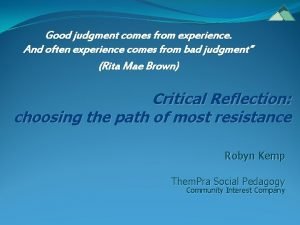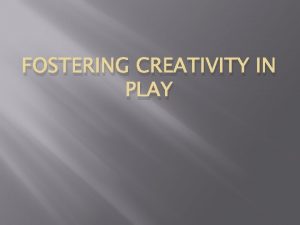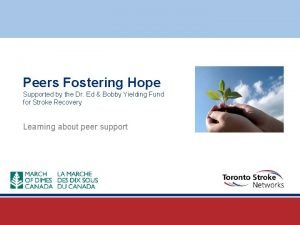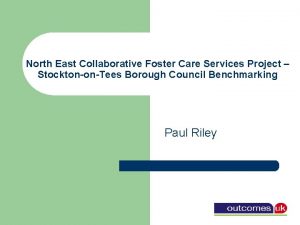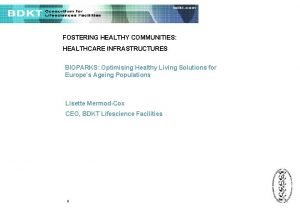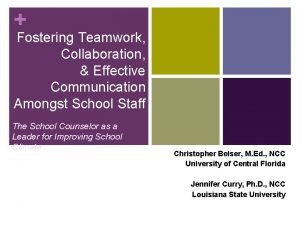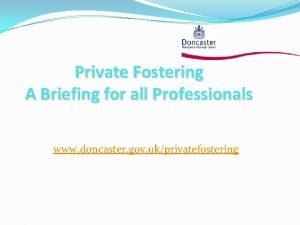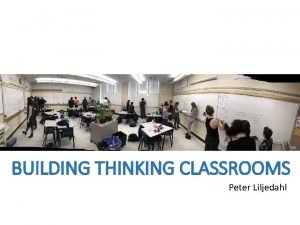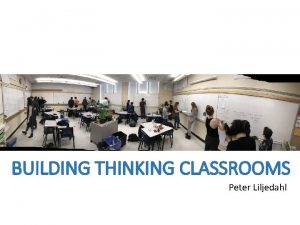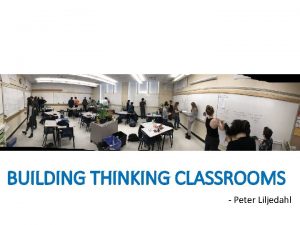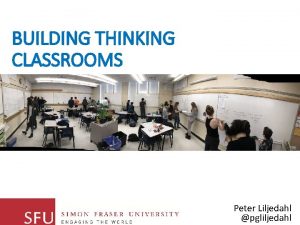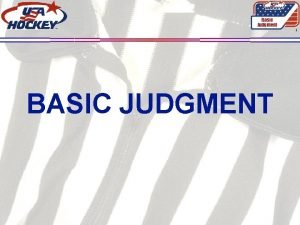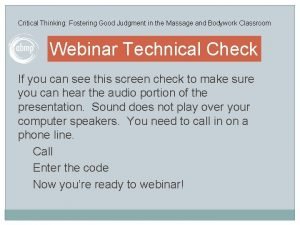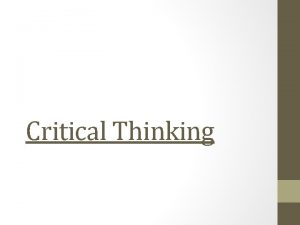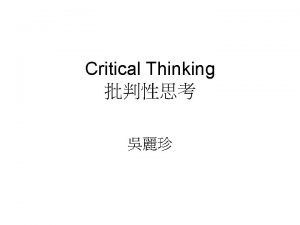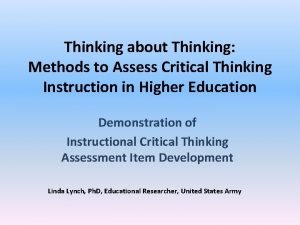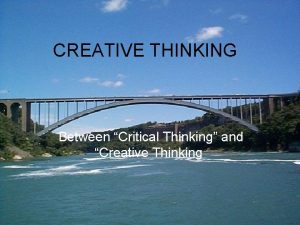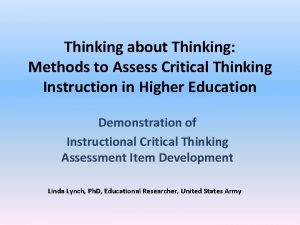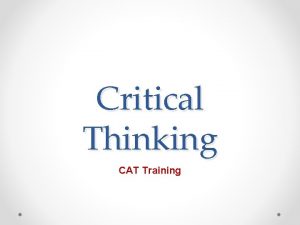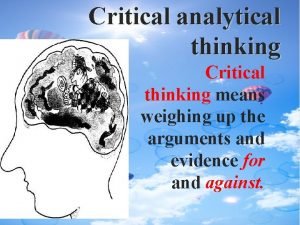Critical Thinking FOSTERING GOOD JUDGMENT IN THE CLASSROOM























- Slides: 23

Critical Thinking FOSTERING GOOD JUDGMENT IN THE CLASSROOM

Goals and Objectives Define critical thinking. Relate critical thinking to the professional practice. Compare and contrast didactic and critical learning strategies. Illustrate the benefits of critical learning.

LEARNING TO LEARN Critical Thinking

Characteristics of Critical Thinking Defining a problem Asking questions Examining evidence Analyzing assumptions and Avoiding oversimplification Considering other interpretations Tolerating ambiguity biases Avoiding emotional reasoning Metacognition (understanding how we process information)

Critical Thinking in Professional Practice Gleaning subjective information Seeking objective information Determining indications/contraindications Session planning and adaptation Documentation Referrals Professional development

Learning Strategies Didactic Method Critical Learning Method Teacher-centered Student-centered What to think How to think Transmit knowledge Facilitate knowledge Content Strategies, principles, concepts, and insights

Learning Strategies (continued) Didactic Method Critical Learning Method Knowledge is additive Knowledge is holistic Experience and values are Doubt and questioning Questioning is a sign of Broad, superficial Focused, deep Direct path to truth Indirect path to truth irrelevant weaken belief essential learning

Establishing structure. Benefits Identifying concepts, facts, or principles. When are didactic methods optimal? Presenting to large groups. Relaying large amounts of information.

Benefits Has relevance to professional practice. Promotes lifelong Why incorporate critical learning? learning. Use in licensing exams.

Application CRITICAL THINKING IN THE CLASSROOM

Instructional Guidelines Become a facilitator. Seed discussion. How do I incorporate critical thinking into established curriculum? Encourage questions. Challenge each other. Focus on why and how. Foster experimentation. Provide feedback.

Example: Kinesiology- Didactic Presentation Objective: Identify the names of the bones in the human skeleton. Delivery: lecture Tools: Power. Point presentation showing skeleton Method: instructor points out all bones and verbally names each while students take notes.

Kinesiology: Didactic Assessment ü Objective: assess each student’s ability to recall the names of the bones in the human skeleton. ü Method: written examination using drawing of human skeleton for students to write in bone names. ü Numeric score based upon number of correct answers.

Objective: analyze and name the bones Kinesiology Critical Learning Presentation of the human skeleton. Delivery: activity Tools: full skeleton and a disarticulated skeleton Method: Each student is given a bone. Instructor presents principles. Student locates bone on skeleton. Student presents name and features. Discuss qualities and function.

Kinesiology Critical Learning Assessment ü Objective: assess each student’s analysis of the bones of the human body. ü Method: written examination using drawing of human skeleton for students to write in bone names and one quality about each bone. ü Numeric score based upon number of correct answers.

Ethics: Didactic Presentation Objective: identify proper ethical behavior associated with discipline. Delivery: lecture. Tools: Power. Point presentation listing the appropriate ethical behavior. Method: instructor reads points from code of ethics or statues, provides a brief explanation of each, and describes how to apply them to professional practice.

Ethics: Didactic Assessment ü Objective: assess each student’s ability to identify proper ethical behavior. ü Method: written examination, using short answer or fill-in to list ethical principles. ü Numeric score based upon number of correct answers.

Ethics Objective: critique ethical dilemmas in Critical Learning Presentation Delivery: activity. work. Tools: pen and paper. Method: Divide class into small groups. Each group creates an ethical dilemma. Trade scenarios and role-play solutions. Discuss to debrief solutions.

Ethics Critical Learning Assessment ü Objective: assess each student’s ability to solve ethical dilemmas using accepted codes and principles. ü Method: essay or verbal exam presenting ethical dilemmas; student must devise a solution, citing a relevant code or law. ü Numeric score based upon content and clarity of answer.

How Are These Methods Different? Critical Learning Didactic Attention Exploration Recall Creativity Recitation Critical Analysis Single path to understanding Indirect paths to understanding Limited learning styles Multiple learning styles

Critical learning CAN be utilized in the Summary classroom. Critical learning is interactive and engaging. Critical thinking is essential to professional practice. Professional organizations are recognizing the value of critical thinking.

Thank You!

Contact ABMP Jennifer Argenbright: jennifer@abmp. com or extension 636 Alaska, Florida, Georgia, Hawaii, Indiana, Michigan, North Carolina, Ohio, Oregon, Puerto Rico, South Carolina, Virgin Islands, Washington Melanie Gourley: melanie@abmp. com or extension 626 California, Delaware, District of Columbia, Maryland, Pennsylvania, Virginia, West Virginia Kathy Laskye: kathy@abmp. com or extension 649 Alabama, Arizona, Illinois, Iowa, Kansas, Kentucky, Minnesota, Mississippi, Missouri, Nebraska, Nevada, New Mexico, North/South Dakota, Tennessee, Utah, Wisconsin Taffie Lewis: taffie@abmp. com or extension 629 Arkansas, Colorado, Connecticut, Idaho, Louisiana, Maine, Massachusetts, Montana, New Hampshire, New Jersey, New York, Rhode Island, Texas, Vermont, Wyoming www. abmp. com 800 -458 -2267
 Critical semi critical and non critical instruments
Critical semi critical and non critical instruments Semi-critical
Semi-critical Perbedaan critical thinking dan creative thinking
Perbedaan critical thinking dan creative thinking Critical judgment and continuous monitoring are examples of
Critical judgment and continuous monitoring are examples of Good judgment comes from
Good judgment comes from Creativity and play fostering creativity
Creativity and play fostering creativity Fostering hope scholarship
Fostering hope scholarship Fostering stockton on tees
Fostering stockton on tees Fostering healthy solutions
Fostering healthy solutions Fostering teamwork
Fostering teamwork Fostering in doncaster
Fostering in doncaster Good thoughts good deeds
Good thoughts good deeds Hello and good evening
Hello and good evening Good afternoon buenas tardes
Good afternoon buenas tardes You are good when theres nothing good in me
You are good when theres nothing good in me Good afternoon buenas tardes
Good afternoon buenas tardes Btech smart classes
Btech smart classes Peter liljedahl thinking classrooms
Peter liljedahl thinking classrooms Peter liljedahl thinking classrooms
Peter liljedahl thinking classrooms Thinking classroom peter liljedahl
Thinking classroom peter liljedahl Peter liljedahl building thinking classrooms
Peter liljedahl building thinking classrooms Thinking classroom peter liljedahl
Thinking classroom peter liljedahl Compare non-critical readers with critical readers.
Compare non-critical readers with critical readers. Barriers to critical thinking
Barriers to critical thinking




